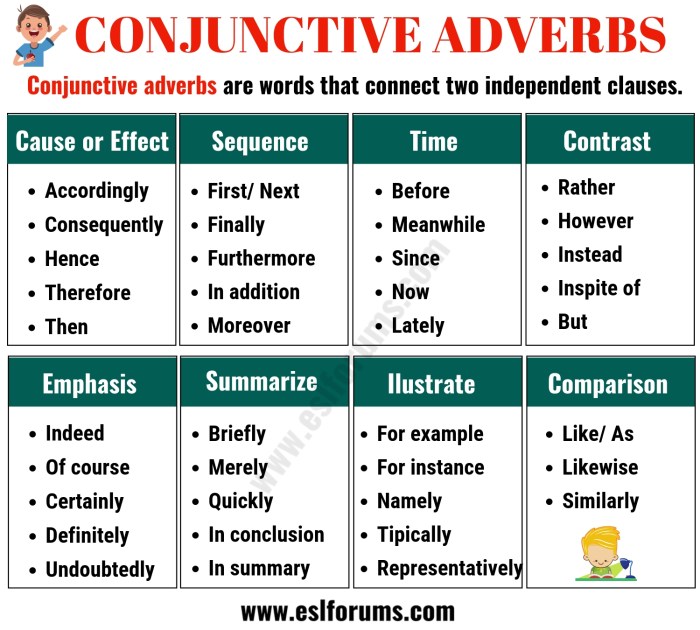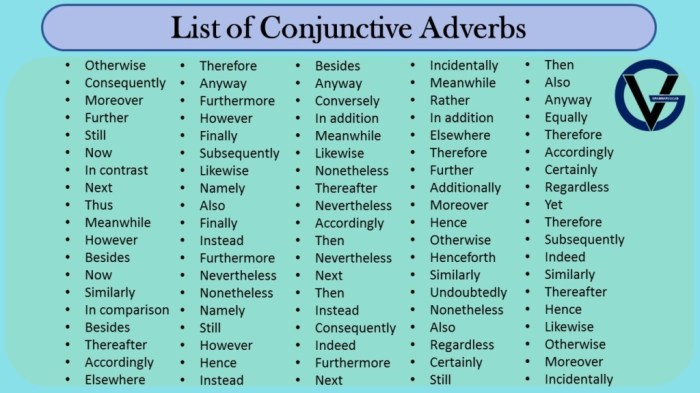Which sentences use conjunctive adverbs check all that apply – This comprehensive guide delves into the realm of conjunctive adverbs, exploring their definition, purpose, and usage. By understanding the nuances of conjunctive adverbs, writers can enhance the flow, coherence, and impact of their written works.
1. Conjunctive Adverbs

Conjunctive adverbs are a type of transitional device that connects sentences or clauses and indicates a specific relationship between them. They are used to create coherence and flow in writing, helping readers understand the logical progression of ideas.
Conjunctive adverbs serve several purposes in sentences:
- They show the relationship between ideas (e.g., addition, contrast, transition).
- They provide a smooth transition between sentences or clauses.
- They add emphasis or clarification to a sentence.
Commonly used conjunctive adverbs include:
- Addition: also, besides, furthermore, moreover
- Contrast: however, nevertheless, on the other hand
- Transition: accordingly, consequently, therefore
2. Identifying Conjunctive Adverbs

Conjunctive adverbs can be identified in sentences based on their function and placement:
- Function:Conjunctive adverbs express specific relationships between sentences or clauses, such as addition, contrast, or transition.
- Placement:They are typically placed at the beginning of a sentence or clause, or between two sentences or clauses.
Tips for recognizing conjunctive adverbs:
- Look for words that signal a connection between ideas.
- Consider the logical relationship between the sentences or clauses.
- Identify words that are placed at the beginning of a sentence or clause.
| Addition | Contrast | Transition | Other |
|---|---|---|---|
| also, besides | however, nevertheless | accordingly, consequently | moreover, furthermore |
3. Usage of Conjunctive Adverbs

Conjunctive adverbs are used to connect sentences or clauses in a variety of ways:
- Addition:Conjunctive adverbs like “also” and “besides” add additional information to a sentence or clause.
- Contrast:Conjunctive adverbs like “however” and “nevertheless” express a contrasting or opposing idea.
- Transition:Conjunctive adverbs like “accordingly” and “consequently” show the logical progression of ideas.
Examples:
- Addition:The weather was perfect. Also, the company was great.
- Contrast:I like to travel. However, I don’t like to fly.
- Transition:The evidence is clear. Consequently, the defendant is guilty.
| Sentence Structure | Conjunctive Adverb | Example |
|---|---|---|
| Sentence 1 + Sentence 2 | also, besides | The weather was perfect. Also, the company was great. |
| Sentence 1 + but + Sentence 2 | however, nevertheless | I like to travel. However, I don’t like to fly. |
| Sentence 1 + so + Sentence 2 | accordingly, consequently | The evidence is clear. Consequently, the defendant is guilty. |
4. Benefits of Using Conjunctive Adverbs

Conjunctive adverbs offer several benefits in writing:
- Improved Sentence Flow:Conjunctive adverbs create a smooth transition between sentences, making the writing more cohesive and easier to read.
- Enhanced Coherence:They clarify the logical relationship between ideas, helping readers understand the progression of thought.
- Increased Clarity:Conjunctive adverbs add emphasis and precision to sentences, making the meaning more apparent.
Examples:
- Improved Sentence Flow:“The weather was perfect. Moreover, the company was great.” (instead of “The weather was perfect. The company was also great.”)
- Enhanced Coherence:“I like to travel. However, I don’t like to fly.” (showing the contrast between two ideas)
- Increased Clarity:“The evidence is clear. Consequently, the defendant is guilty.” (emphasizing the logical connection between the evidence and the verdict)
FAQ Section: Which Sentences Use Conjunctive Adverbs Check All That Apply
What are conjunctive adverbs?
Conjunctive adverbs are transitional words or phrases that connect two independent clauses while also expressing a specific relationship between them, such as addition, contrast, or transition.
How can I identify conjunctive adverbs in sentences?
Conjunctive adverbs are typically placed between two independent clauses, often preceded by a semicolon or comma. They can also appear at the beginning of a sentence.
What are some common examples of conjunctive adverbs?
Some frequently used conjunctive adverbs include however, therefore, moreover, nevertheless, and consequently.